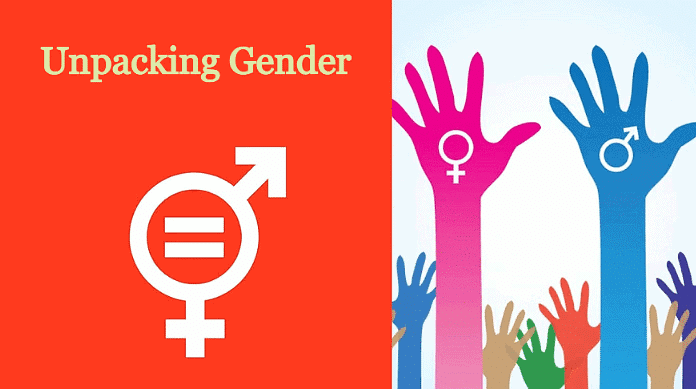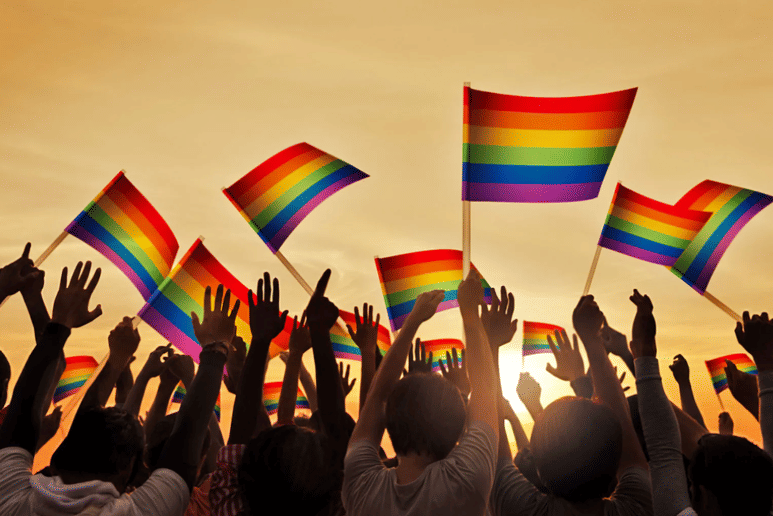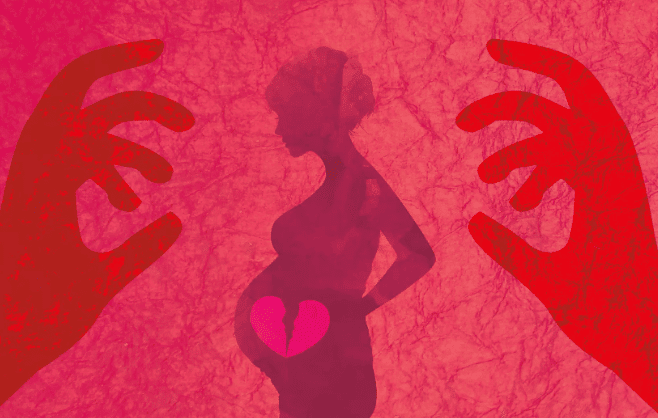Notes: Unpacking Gender | Social Studies & Pedagogy Paper 2 for CTET & TET Exams - CTET & State TET PDF Download
Introduction
The term gender is frequently used but often misunderstood. Many individuals use it without fully comprehending its implications. The perception of gender is shaped by socialization within family and society, with education further reinforcing these understandings. Traditionally, gender has been associated primarily with women, creating a limited perspective.
In reality, gender encompasses a broad spectrum, including boys, girls, and the third gender, which may include homosexuals, eunuchs, and other identities. A more comprehensive understanding of gender extends beyond radical feminist perspectives and acknowledges its multifaceted nature.

Distinction Between Sex and Gender
The terms sex and gender are often used interchangeably, though they refer to distinct concepts:
Sex is biologically determined, linked to sex chromosomes, hormones, and reproductive systems, identifying individuals as male or female.
Gender is a social construct shaped by relationships and societal perceptions. It involves biology, personal identity, and behavioral expression, influencing both self-perception and external perception by society.
Beyond the Binary Concept of Gender
Gender should not be viewed as a binary system (male and female) but as a multidimensional construct influenced by social, political, cultural, and economic factors. While sex organs define biological sex, gender encompasses various societal dimensions that shape identity and roles. Defining gender merely as a social construct limits its complexity and depth.
The socio-economic and political environment plays a crucial role in shaping gender perceptions. Several factors contribute significantly to the development of gender identities:
Family and parents
Peers and social interactions
Education and curriculum
Government policies and laws
Society reinforces these constructed notions throughout an individual's life, from birth to death, affecting toys, clothing, education, colors, social behaviors, and interpersonal relationships.
Patriarchy and Gender Hierarchies
This division of roles often leads to the dominance of one gender over others, a system known as patriarchy. In this framework:One gender is positioned as superior, while others become subordinate.
This dynamic is evident across various aspects of life and frequently serves as a tool for exploitation.
The struggle for women's rights and equality, though significant, has often remained confined within existing power structures.
Challenges in Feminist Movements and Gender Equality
The feminist movement, despite its efforts, has faced challenges in redefining gender roles beyond existing ideologies. Some aspects of the movement have sought to validate women by comparing them to men, rather than promoting self-identity and autonomy.There has been a tendency to devalue women's traditional roles, a notion reinforced by both patriarchy and certain feminist arguments.
Instead of empowering women’s contributions, some movements have focused on replicating male roles, which has led to fundamental issues in gender discourse.
Gender equality should not be about mirroring the roles of another gender but about fostering a self-identity that is independent of societal approval.
Expanding the Understanding of Gender Beyond Male and Female
A stereotypical perspective confines gender to male and female categories, failing to represent its full spectrum. The third gender includes various subcategories such as:
Eunuchs
Homosexuals
Transgenders
Asexuals
These individuals face unique challenges that must be addressed within gender discourse. A comprehensive discussion on gender should acknowledge and incorporate these identities.

Gender variations have existed throughout history, influenced by both biological and social factors. The primary focus should be on ensuring equality for all individuals, regardless of gender or sexual orientation.
Addressing Privileges and Discrimination
Gender-based privileges create discrimination in various spheres, including family and public life. Two fundamental questions need to be addressed:
Is true gender equality attainable?
Or is it beyond practical application?
If preconceived notions about the immutability of gender roles persist, progress will be minimal. However, an open and inclusive mindset can lead to meaningful change. Encouraging equitable opportunities is essential for fostering a society where gender does not become a barrier to recognition and success.
Key Concepts in Gender Discourse
1. Sex (Biological)
Sex is a biological concept, directly related to reproductive organs, forming the primary distinction between male and female. It is purely physical and has no direct relation to society. Some studies suggest that homosexuality is influenced by socialization, but the majority favor biological determinants. The sex of a child is determined at conception:
XX chromosomes produce a female child.
XY chromosomes produce a male child.
Intersex (Eunuch) individuals are also a biological construct. (Note: Here, we are not referring to transgender individuals.)
2. Gender Identity
Gender identity is how an individual perceives themselves—male, female, both, or neither. This identity is shaped by various factors, including political, social, and economic influences. While most people align their gender identity with their biological sex, some do not and identify differently.
3. Expression of Gender
This refers to how individuals present their gender identity through aspects such as:
Hairstyle
Voice
Behavior
Clothing choices
Gender expression can be influenced by social norms. Some individuals feel compelled to conform to their biological sex’s expected behavior, while others suppress their authentic expression due to societal pressure.
4. Gender Role
Gender roles are societal expectations assigned to males and females. These roles dictate behavior and responsibilities, reinforcing notions of masculinity and femininity. Any deviation from these traditional roles is often stigmatized, leading to labels such as eunuch, transgender, or homosexual. Transgender is a broad term encompassing those whose identity falls outside traditional male-female classifications.
5. Orientation towards Sex
Sexual orientation is categorized primarily into:
Heterosexual (attraction to the opposite sex) – socially and legally accepted in most societies.
Homosexual (attraction to the same sex) – not considered natural or legal in many nations.
Asexual (lack of sexual attraction) – an existing but lesser-discussed category.
Despite the existence of diverse orientations, non-heterosexual identities often face stigma and discrimination.
6. Fluidity in Gender
Gender fluidity challenges rigid gender norms. Individuals may experience shifts in their gender identity and expression over time. This perspective allows people to live authentically without imposed restrictions, recognizing gender as a spectrum rather than a fixed binary.
Issues and Challenges in Gender Equality
1. Inequality
Gender inequality persists globally in multiple forms:
Unequal status and rights
Wage disparities
Gender-based societal expectations
These inequalities manifest differently in rural and urban settings, impacting opportunities and life choices for individuals of all genders.
2. Accountability and Responsibility
Despite legal provisions for gender equality, implementation remains weak due to:
Lack of monitoring mechanisms
Weak judicial enforcement
Social systems that perpetuate discrimination
A stricter accountability framework is needed to ensure rights are not just theoretical but actively enforced.
3. Perceiving Women’s Contribution
Women’s contributions have historically been associated with domestic responsibilities. Even in professional fields, they are often linked to roles like teaching and nursing. Despite workforce participation, women continue to bear household responsibilities, limiting their opportunities and human rights.
4. Policy-Level Issues and Poor Monitoring
For true gender equality, policies must be multi-sectoral, covering:
Education
Healthcare
Legal reforms
Economic opportunities
However, many policies operate in isolation, benefiting only select individuals. Poor awareness and weak monitoring systems further hinder their effectiveness.
5. Inadequate Research
Research on gender issues is often:
One-sided, portraying one gender as an oppressor and the other as a victim.
Focused on rivalry rather than equality.
Lacking comprehensive discourse to build an egalitarian society.
A more balanced approach is needed to foster constructive discussions.
6. Neglected Issues
Many gender-related issues remain unattended or superficially addressed. These include:
Female foeticide
Marginalization
Sexual violence
Public health concerns
Education disparities

Government policies exist but lack visible impact, necessitating stronger enforcement and awareness campaigns.
7. Social Stigmas and Fear of Retaliation
Oppressed groups, particularly women, often hesitate to seek justice due to:
Fear of social judgment.
Moral conditioning discouraging them from speaking out.
Economic dependence.
Hierarchical decision-making structures limiting autonomy.
Poor awareness of legal rights.
Social pressures often outweigh legal protections, preventing individuals from challenging systemic oppression.
Gender Roles in India
1. Industrialisation and Diverging Gender Roles
Industrialisation led to diverging gender roles between India and European countries.
Before the Industrial Revolution (17th-18th centuries), gender roles around the world were mostly similar. In earlier times, household sustenance required substantial labour, and almost every family member contributed. In farming communities, men typically managed labour-intensive, outdoor work, while women were responsible for food, home, and childcare.
This division of labour was common across agricultural societies. However, in India, the family was the central unit of life, and women’s roles had unique aspects dating back to ancient times.
2. Gender Roles in Indian Families
In Indian families, women play a central role. Men traditionally managed labour-intensive outdoor work, while women took care of the home, food, and children.
Rural women enjoyed relative independence due to strong social bonding in villages.
Social values were deeply enshrined in rural society, providing security and mutual trust, which resulted in fewer restrictions on women compared to urban centres.
3. Changes During the 20th Century
Since the second half of the 20th century (post-independence), gender roles have undergone significant change:
Women started formal schooling and entered prestigious jobs.
Middle-class women increasingly joined education and employment sectors, but traditional expectations persisted.
Working women are still expected to manage household responsibilities despite contributing equally at work.
Women’s aspirations continue to evolve in modern India.
Sexual freedom has increased, and extramarital relationships are becoming more open.
Divorce, once rare, is now rising.
The family remains central to society, but individualism is gaining prominence.
The Government of India mandates creche facilities for organisations employing 30 or more female employees to facilitate women’s workforce participation.
Women’s Movement
Women’s rights—such as access to education, legal reforms, protection from violence, and healthcare improvements—were achieved through prolonged struggles known as the women’s movement. Various strategies have been used to fight discrimination and seek justice:
Campaigning
A key aspect of the women’s movement.
Example: The 2006 law against domestic violence.
The Supreme Court formulated guidelines in 1997 for the prevention of workplace sexual harassment.
In the 1980s, nationwide protests against dowry deaths led to legal reforms.
Raising Awareness
Public awareness campaigns through street plays, songs, and public meetings.
Protesting
Demonstrations, public rallies, and protests to highlight injustices against women.
Showing Solidarity
Support for fellow women and related social causes.
Political Participation of Women in India
Women’s political participation has seen slow progress.
The first Lok Sabha had only 4.4% women members.
The number of women MPs increased from 58 to 61 in the current Lok Sabha but remains below the global average of 21.3%.
The 73rd and 74th Constitutional Amendment Acts (1993) introduced 33% reservation for women in local self-government bodies.
Notable Women in the Movement
1. Pandita Ramabai
Campaigned for women’s education despite never attending school herself.
Taught by her parents and earned the title ‘Pandita’ for her Sanskrit literacy.
Founded a mission in Khadgaon (near Pune) in 1898 to help widows and poor women become literate and self-reliant.
Trained women in diverse skills, including carpentry and printing.
Ramabai’s Mission is still active today.
2. Rokeya Sakhawat Hussain
Born into a wealthy family but was restricted from learning Bangla and English.
Secretly learned Bangla from her elder siblings.
Became a writer and published Sultana’s Dream (1905), envisioning a utopian society where women enjoyed full freedom and innovation.
3. Laxmi Lakra
Became an engine driver with the Northern Railway, breaking gender stereotypes.
Inspired by figures like astronaut Kalpana Chawla.
Constitutional Provisions for Gender Equality in India
The Indian Constitution includes various provisions to ensure gender equality:
Article 14: Equality before law for all persons.
Article 15(1): Prohibition of discrimination based on religion, sex, race, caste, or place of birth.
Article 15(3): Special provisions for women and children.
Article 16: Equal opportunities in employment.
Article 39(1): Promotion of justice based on equal opportunity for men and women.
Article 39(4): Equal pay for equal work.
Article 42: Ensures humane work conditions and maternity relief.
Article 51A(e): Promotes harmony and eliminates practices derogatory to women’s dignity.
Articles 243(D) & 243(T): Reservation of one-third of seats for women in local self-governance bodies (panchayats and municipalities).
|
75 videos|311 docs|77 tests
|
FAQs on Notes: Unpacking Gender - Social Studies & Pedagogy Paper 2 for CTET & TET Exams - CTET & State TET
| 1. What are the main challenges faced by feminist movements today? |  |
| 2. How can gender be understood beyond the binary of male and female? |  |
| 3. What are some key concepts in gender discourse that are important for understanding gender equality? |  |
| 4. What specific issues and challenges are prevalent in achieving gender equality in India? |  |
| 5. How has the women's movement in India evolved over the years? |  |





















